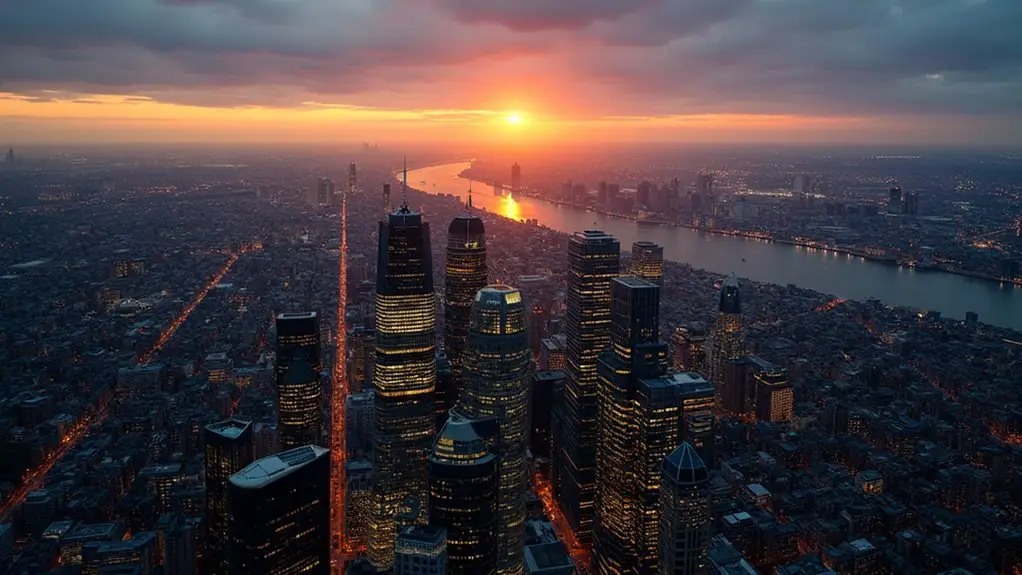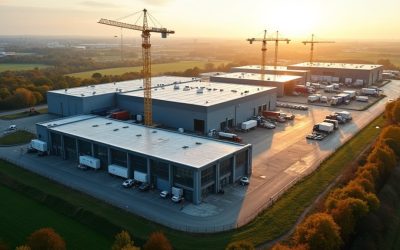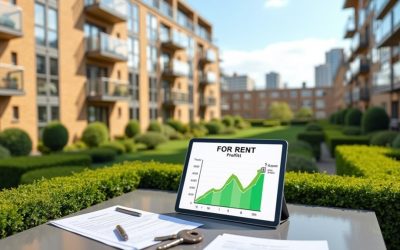Urban living is experiencing a remarkable resurgence globally, with 55% of the world’s population now residing in cities. You’ll find this trend accelerating toward 68% by 2050, driven by economic opportunities, improved services, and technological conveniences. While North America leads with 82% urbanization, even previously declining Northeast and Midwest cities show positive growth. Meanwhile, rural areas continue losing population share as metropolises like Dallas-Fort Worth add millions of residents. The future environment of human habitation clearly tilts toward concrete jungles over countryside retreats.

While rural communities once defined human settlement patterns, cities now dominate global population distribution at unprecedented levels. The shift toward urbanization has accelerated dramatically since the mid-20th century, with world urban population soaring from 751 million in 1950 to approximately 4.2 billion in 2018.
You’re witnessing a global transformation that’s reshaping human geography. By 2050, projections indicate that 68% of the world’s population will live in urban areas, up from 55% in 2018. This isn’t happening evenly across the globe, though.
North America leads this urban revolution with over 82% of its population residing in cities. Latin America and the Caribbean follow closely at 81%, while Europe and Oceania show strong urban concentrations at 74% and 68% respectively.
Asia, despite hosting 54% of the world’s urban dwellers, maintains a moderate urbanization rate of about 50%. Africa remains mainly rural with only 43% of its population in urban settings.
The United States exemplifies recent urban growth trends, with cities of all sizes gaining population between 2023 and 2024. You’ll find the most dramatic growth in Southern and Western regions, with Princeton, Texas achieving an astonishing 30.6% population increase in just one year.
Economic opportunities drive much of this urban migration. Cities offer concentrated job markets, improved infrastructure, and better access to services that rural areas often lack. Technological advancements have made urban living more convenient and connected than ever before.
Climate change also plays a role in urban growth, as some populations relocate to cities seeking resources and protection from environmental challenges facing rural areas.
This urban renaissance isn’t limited to new growth centers. Many Northeast and Midwest cities that previously experienced population declines have reversed course, now showing positive growth trends. This transition is creating significant strain on transportation systems as urban density increases beyond infrastructure capacity.
The Dallas-Fort Worth metro area exemplifies this urban dominance, having added over 1 million residents in just the past decade while maintaining relatively affordable housing compared to other major metropolitan areas.
As you look toward the future, expect countries like India, China, and Nigeria to lead urban expansion, collectively contributing 35% of global urban growth between 2018 and 2050. Cities, not countryside, will increasingly define where and how people live worldwide.
Frequently Asked Questions
How Do Rural and Urban Costs of Living Compare?
You’ll find urban areas generally have a higher overall cost of living, primarily due to housing expenses that can be 70% more expensive than rural alternatives.
While your income potential may be greater in cities, you’ll face higher housing costs, local taxes, and daily expenses.
Rural living offers considerable housing savings, but you’ll likely spend more on transportation and utilities.
Your lifestyle choices will determine whether the financial trade-offs of either environment align with your priorities.
What Environmental Impacts Result From Urban Population Growth?
As urban populations grow, you’ll see several environmental impacts develop around you.
Cities increase greenhouse gas emissions through energy use, transportation, and industrial activity.
Buildings alone account for 40% of energy consumption in European cities.
You’ll notice habitat loss in biodiversity hotspots and decreased vegetation, which reduces carbon storage.
Urban development alters water cycles by increasing runoff and flood risks while reducing groundwater recharge.
These environmental stresses often disproportionately affect vulnerable urban populations in your community.
Are Crime Rates Higher in Urban or Rural Areas?
You’ll find that crime rates are consistently higher in urban areas compared to rural locations.
The data shows urban violent crime rates at 33.4 per 1,000 people, more than double the rural rate of 15.4.
Property crimes follow a similar pattern with urban areas experiencing 176.1 incidents per 1,000 people versus 61.7 in rural regions.
While all areas face distinct crime challenges, population density and socioeconomic factors heavily influence these statistical differences.
How Has Remote Work Affected Urban-Rural Migration Patterns?
Remote work has dramatically shifted migration patterns between urban and rural areas.
You’re witnessing a substantial movement of remote workers from major cities to suburban and rural locations, with small-town home prices surging 42% since 2020.
This migration is reshaping both environments.
Rural areas benefit from increased local spending and infrastructure improvements like broadband expansion.
Meanwhile, urban centers with jobs suitable for remote work experience population declines and decreased foot traffic in business districts.
What Healthcare Disparities Exist Between Urban and Rural Communities?
You’ll find considerable healthcare disparities between rural and urban communities.
Rural areas have 39% higher patient loads per primary care physician and fewer dentists per capita.
You face more barriers to specialized care in rural settings, often presenting with more advanced disease stages.
Rural communities also struggle with socioeconomic factors that worsen health outcomes – lower incomes, higher poverty rates, and greater geographic isolation all contribute to healthcare access challenges.


